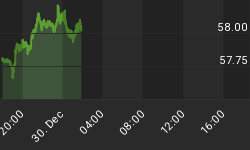Below is an extract from a commentary originally posted at www.speculative-investor.com on 11th June 2006.
Current Market Situation
During the long-term bull market in gold stocks there have, to date, been two intermediate-term corrections (the 2001 and 2002 corrections) and one primary correction (the Dec-2003 to May-2005 correction). However, the following weekly chart of the HUI shows that none of these corrections resulted in a move below the second-to-last intermediate-term high. Assuming, therefore, that the current correction will turn out to be no worse than the previous intermediate-term or major corrections, the Dec-2003 peak of 260 should not be breached. In other words, the HUI's maximum downside potential from Friday's closing price of 299 is probably about 12%.

We continue to think that 280 is the most likely level for an intermediate-term price low. The HUI traded as low as 286 on Thursday, so it's possible that a low is already in place. If so then the low has been put in place a few weeks earlier than originally expected. There's a good chance that last week's low will be tested over the coming 2 weeks, but the short-term reward now appears to be significantly greater than the short-term risk.
Adding weight to the idea that an intermediate-term price low might already be in place is the fact that the cumulative net cash flow into the Rydex Precious Metals Fund has just dropped to near its lowest levels of the past 2.5 years (see chart below). This demonstrates remarkable disinterest in gold/silver stocks on the part of the investing public and this, in turn, suggests that most of the weak hands have been chased out of the market by the recent correction.

Those who have been waiting for a good opportunity to build up exposure to the gold sector should do some buying now. However, it doesn't make sense to jump in with both feet at this time because although last week's low was probably either the HUI's ultimate price low for the current correction or within a few percent of its ultimate price low, the overall correction is likely to last until at least November of this year and might even extend into the first half of 2007.
The pattern during the previous intermediate-term corrections entailed a price low being put in place during the first two months of the correction followed by several months of 'basing' before the next intermediate-term advance got underway. During this 'basing period' the HUI has tended to make a number of successful tests of its low while many small-cap stocks have made progressively lower lows. The small-cap gold and silver stocks are generally the ones we favour because this is where most of the value and the greatest long-term upside potential can be found, but keep in mind that the juniors are called "late stage stocks" for a reason: they tend to show relative strength during the late stages of intermediate-term advances and relative weakness during the late stages of intermediate-term declines.
Valuations of the major gold stocks continue to puzzle us
In the 8th May Weekly Market Update we said that if everything were the same with Pan American Silver (NASDAQ: PAAS) except that it mined copper instead of silver then it would likely be valued by the stock market at no more than US$5 per share. The stock was trading at US$22 at the time, and even though it has since fallen to around $17 an investor would have to either be blind to value or not care about value to think that he/she was getting a good deal at the current price. We aren't saying that PAAS won't rebound strongly from its current 'oversold' extreme; we are saying that its market capitalisation is extraordinarily high relative to the size and profitability of its underlying business.
It's a similar story with the major gold mining companies. Goldcorp (NYSE: GG), for instance, despite having had its market capitalisation slashed by around 35% over the past few weeks, still trades at 28-times trailing earnings and an eye-popping 9.4-times annual sales. By comparison, major copper producer Phelps Dodge (NYSE: PD) trades at 10.8-times trailing earnings and 1.8-times annual sales. PD's current valuation is, by the way, in line with those of most other major non-gold/silver mining companies.
Further to the above, if Goldcorp were known as a copper producer rather than as a gold producer it would probably be priced at around US$10/share as opposed to its current $26/share. This doesn't mean that the Goldcorp stock price won't continue to trend higher over the coming years. In fact, we expect that it will continue to trend higher because during long-term bull markets valuations keep expanding even after they have reached levels that seem absurd to the value-conscious investor. However, it probably means that GG will never be part of the TSI Stocks List, except perhaps as a short-term trade. We know, from past experience, that we will be easily shaken-out of a stock (we will be unable to ride-out the corrections) if we aren't confident that the stock's price is solidly supported by the value of the underlying business. To mitigate the risk of being shaken-out of our position at an inopportune time we won't buy or recommend a stock as an investment unless we are confident that it offers good value.
















